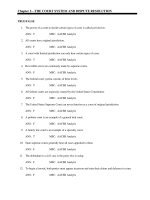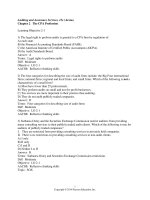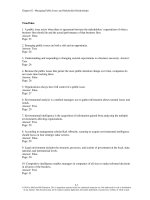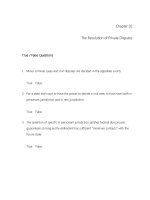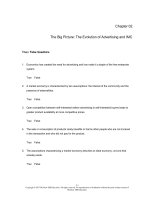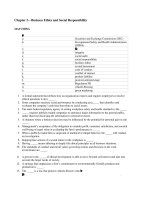Business and society stakeholders ethics public policy 15th edition lawrence test bank
Bạn đang xem bản rút gọn của tài liệu. Xem và tải ngay bản đầy đủ của tài liệu tại đây (310.13 KB, 36 trang )
Chapter 02
Managing Public Issues and Stakeholder Relationships
True / False Questions
1. A public issue exists when there is agreement between the stakeholders' expectations of what a
business firm should do and the actual performance of that business firm.
True
False
2. Emerging public issues are both a risk and an opportunity.
True
False
3. Understanding and responding to changing societal expectations is a business necessity.
True
False
4. Because the public issues that garner the most public attention change over time, companies do
not waste time tracking them.
True
False
5. Organizations always have full control of a public issue.
True
False
2-1
Copyright © 2017 McGraw-Hill Education. All rights reserved. No reproduction or distribution without the prior written consent of
McGraw-Hill Education.
6. Environmental analysis is a method managers use to gather information about external issues
and trends.
True
False
7. Environmental intelligence is the acquisition of information gained from analyzing the multiple
environments affecting organizations.
True
False
8. Legal environment includes the structure, processes, and actions of government at the local,
state, national, and international levels.
True
False
9. Competitive intelligence enables managers in companies of all sizes to make informed decisions
in all areas of the business.
True
False
10. Stakeholder materiality is a method companies use to prioritize the relevance of the stakeholders
and their issues.
True
False
11. In the issue management process, identifying the issue involves anticipating emerging issues.
True
False
2-2
Copyright © 2017 McGraw-Hill Education. All rights reserved. No reproduction or distribution without the prior written consent of
McGraw-Hill Education.
12. Financially sound companies do not need to understand how a public issue is likely to evolve, or
how it will affect them.
True
False
13. For stakeholder engagement to occur, both the business and the stakeholder must be motivated
to work with one another to solve the problem.
True
False
14. Dialogue between a single firm and its stakeholders is always sufficient to address an issue
effectively.
True
False
15. Companies are learning that it is important to take a strategic approach to the management of
public issues, both domestically and globally.
True
False
Multiple Choice Questions
16. Public issues are also sometimes referred to as:
A. Social issues.
B. Sociopolitical issues.
C. Both A and B.
D. None of the above.
2-3
Copyright © 2017 McGraw-Hill Education. All rights reserved. No reproduction or distribution without the prior written consent of
McGraw-Hill Education.
17. The emergence of a public issue indicates that:
A. A gap has developed between what stakeholders expect and what an organization is actually
doing.
B. Technology is forcing ethics and business strategy closer together.
C. Consumers are unaware of how an organization's actions affect them.
D. All of the above.
18. Failure to understand the beliefs and expectations of stakeholders:
A. Causes a company's profits to increase in the short run.
B. Causes a company's profits to decrease in the short run.
C. Causes the performance-expectations gap to grow larger.
D. Increases the chance of a corporate buy-out.
19. Because of the risks and opportunities public issues present, organizations need:
A. A strong relationship with a lobbying firm or an in-house lobbying department.
B. Executives to be rewarded with substantial bonuses as part of total compensation.
C. A systematic way of identifying, monitoring, and selecting public issues.
D. Tougher government regulations and oversight by political action committees.
2-4
Copyright © 2017 McGraw-Hill Education. All rights reserved. No reproduction or distribution without the prior written consent of
McGraw-Hill Education.
20. Customer environmental intelligence includes:
A. Demographic factors.
B. An analysis of the firm's competitors.
C. New technological applications.
D. The cost of producing consumer goods.
21. According to management scholar Karl Albrecht, scanning to acquire environmental intelligence
should focus on:
A. Eight strategic radar screens.
B. Six management templates.
C. Eight process improvement models.
D. Six ethical decision indicators.
22. The explosive use of social media is an example of:
A. Customer environment.
B. Competitor environment.
C. Economic environment.
D. Social environment.
2-5
Copyright © 2017 McGraw-Hill Education. All rights reserved. No reproduction or distribution without the prior written consent of
McGraw-Hill Education.
23. An analysis of the stability or instability of a government is an example of scanning the:
A. Social environment.
B. Legal environment.
C. Geophysical environment.
D. Political environment.
24. Legal environmental intelligence includes:
A. Patterns of aggressive growth versus static maintenance.
B. Analysis of local, state, national, and international politics.
C. Considerations of patents, copyrights, or trademarks.
D. Information regarding costs, prices, and international trade.
25. The role of special interest groups is an important element in acquiring intelligence from the:
A. Customer environment.
B. Competitor environment.
C. Economic environment.
D. Social environment.
26. The relevance and importance of stakeholders and their issues is known as:
A. Stakeholder salience.
B. Competitive intelligence.
C. Stakeholder materiality.
D. Organizational capacity.
2-6
Copyright © 2017 McGraw-Hill Education. All rights reserved. No reproduction or distribution without the prior written consent of
McGraw-Hill Education.
27. The issues management process is a:
A. Beneficial tool used only to maximize the positive effects of a public issue for the organization's
advantage.
B. Beneficial tool used only to minimize the negative effects of a public issue for the
organization's advantage.
C. Systematic process companies use when responding to public issues that are of greatest
importance to the business.
D. Confusing process that is rarely used to help top management within an organization.
28. The issue management process has how may stages?
A. Three.
B. Four.
C. Five.
D. Six.
29. The components of a typical issues management process include:
A. Identify issue.
B. Generate options.
C. Take action.
D. All of the above.
2-7
Copyright © 2017 McGraw-Hill Education. All rights reserved. No reproduction or distribution without the prior written consent of
McGraw-Hill Education.
30. Once an issue has been identified, its implications must be:
A. Acted upon.
B. Analyzed.
C. Segmented.
D. Deleted.
31. An issue's public profile indicates to managers:
A. How significant an issue is for the organization, but it does not tell them what to do.
B. Both how significant an issue is for the organization and exactly what to do.
C. Exactly what to do without indicators of how significant an issue is for the organization.
D. Any of the above depending on the organization type.
32. Once an organization has implemented the issue management program, it must:
A. Use trade associations or consultants to follow high priority issues.
B. Study the results and make necessary adjustments.
C. Not limit the number of public issues the firm can address.
D. Pick a selected number of issues to address immediately.
33. When working well, the issue management process:
A. Is static and never pulls in additional information that would disturb the balance.
B. Generates two specific options for each issue.
C. Minimizes dialogue with the stakeholders and focuses on short-term survival.
D. Continuously cycles back to the beginning and repeats.
2-8
Copyright © 2017 McGraw-Hill Education. All rights reserved. No reproduction or distribution without the prior written consent of
McGraw-Hill Education.
34. Contemporary issue management:
A. Is a linear process.
B. Was useful in the 1970s, but not today.
C. Is used by all government agencies.
D. Is an interactive, forward thinking process.
35. A leadership role in addressing emerging management issues in often taken by:
A. The public affairs department.
B. The government relations department.
C. The department of sustainability or environmental, health and safety.
D. All of the above.
36. A corporation's issue management activities are usually linked to:
A. The board of directors.
B. Top management.
C. Both the board of directors and top management levels.
D. The strategic governance committee.
37. Over time, the nature of business's relationship with its stakeholders often:
A. Remains static.
B. Evolves through a series of stages.
C. Becomes more hostile.
D. None of the above.
2-9
Copyright © 2017 McGraw-Hill Education. All rights reserved. No reproduction or distribution without the prior written consent of
McGraw-Hill Education.
38. Firms that believe they can make decisions unilaterally, without taking into consideration their
impact on others are:
A. Interactive companies.
B. Proactive companies.
C. Reactive companies.
D. Inactive companies.
39. Firms that generally act only when forced to do so, and then in a defensive manner are:
A. Interactive companies.
B. Proactive companies.
C. Reactive companies.
D. Inactive companies.
40. Proactive companies are:
A. Much less likely to be blindsided by crises and negative surprises.
B. Much more likely to be blindsided by crises and negative surprises.
C. Just as likely to be blindsided by crises and negative surprises.
D. Much more likely to be forced to defend itself in a lawsuit brought by a stakeholder.
2-10
Copyright © 2017 McGraw-Hill Education. All rights reserved. No reproduction or distribution without the prior written consent of
McGraw-Hill Education.
41. Stakeholder engagement is:
A. Any issue that is of mutual concern to an organization and one or more of its stakeholders.
B. Competitive intelligence being collected ethically and systematically.
C. The process of ongoing relationship building between a business and its stakeholders.
D. The acquisition of information gained from analyzing the multiple environments.
42. Stakeholder engagement is, at its core, a:
A. Program.
B. Relationship.
C. Process.
D. Systems model.
43. The drivers of stakeholders of engagement are:
A. Scanning, assessment, and growth.
B. Data, strategy, and organizational development.
C. Goals, motivation, and operational capacity.
D. Financial, operational, and legal.
2-11
Copyright © 2017 McGraw-Hill Education. All rights reserved. No reproduction or distribution without the prior written consent of
McGraw-Hill Education.
44. A business and its stakeholders coming together for face-to-face conversations about issues of
common concern is:
A. Stakeholder networks.
B. Stakeholder motivation.
C. Stakeholder systems.
D. Stakeholder dialogue.
45. Corporations working collaboratively with other businesses and concerned persons and
organizations is an example of:
A. Stakeholder networks.
B. Stakeholder motivation.
C. Stakeholder systems.
D. Stakeholder salience.
Short Answer Questions
46. What is a public issue and how do they impact modern firms?
2-12
Copyright © 2017 McGraw-Hill Education. All rights reserved. No reproduction or distribution without the prior written consent of
McGraw-Hill Education.
47. What is competitive intelligence? Why is it important to the public affairs function?
48. Identify the eight strategic radar screens that enable public affairs managers to scan their
business environment. Briefly discuss the issues involved with each environment.
49. Give an example and explain why stakeholder materiality is important to both the company and
its stakeholders.
2-13
Copyright © 2017 McGraw-Hill Education. All rights reserved. No reproduction or distribution without the prior written consent of
McGraw-Hill Education.
50. Identify and discuss the five steps to the Issues Management Process.
51. What are the various stages of the business-stakeholder relationship?
52. Engaging interactively with stakeholders carries a number of potential benefits. Discuss.
2-14
Copyright © 2017 McGraw-Hill Education. All rights reserved. No reproduction or distribution without the prior written consent of
McGraw-Hill Education.
Chapter 02 Managing Public Issues and Stakeholder Relationships
Answer Key
True / False Questions
1.
A public issue exists when there is agreement between the stakeholders' expectations of what
a business firm should do and the actual performance of that business firm.
FALSE
Accessibility: Keyboard Navigation
Difficulty: 1 Easy
Learning Objective: 02-01 Identifying public issues and analyzing gaps between corporate performance and stakeholder
expectations.
2.
Emerging public issues are both a risk and an opportunity.
TRUE
Accessibility: Keyboard Navigation
Difficulty: 1 Easy
Learning Objective: 02-01 Identifying public issues and analyzing gaps between corporate performance and stakeholder
expectations.
3.
Understanding and responding to changing societal expectations is a business necessity.
TRUE
Accessibility: Keyboard Navigation
Difficulty: 1 Easy
Learning Objective: 02-01 Identifying public issues and analyzing gaps between corporate performance and stakeholder
2-15
Copyright © 2017 McGraw-Hill Education. All rights reserved. No reproduction or distribution without the prior written consent of
McGraw-Hill Education.
expectations.
4.
Because the public issues that garner the most public attention change over time, companies
do not waste time tracking them.
FALSE
Accessibility: Keyboard Navigation
Difficulty: 1 Easy
Learning Objective: 02-01 Identifying public issues and analyzing gaps between corporate performance and stakeholder
expectations.
5.
Organizations always have full control of a public issue.
FALSE
Accessibility: Keyboard Navigation
Difficulty: 1 Easy
Learning Objective: 02-01 Identifying public issues and analyzing gaps between corporate performance and stakeholder
expectations.
6.
Environmental analysis is a method managers use to gather information about external issues
and trends.
TRUE
Accessibility: Keyboard Navigation
Difficulty: 1 Easy
Learning Objective: 02-02 Applying available tools or techniques to scan an organization's multiple environments and
assessing stakeholder materiality.
2-16
Copyright © 2017 McGraw-Hill Education. All rights reserved. No reproduction or distribution without the prior written consent of
McGraw-Hill Education.
7.
Environmental intelligence is the acquisition of information gained from analyzing the multiple
environments affecting organizations.
TRUE
Accessibility: Keyboard Navigation
Difficulty: 1 Easy
Learning Objective: 02-02 Applying available tools or techniques to scan an organization's multiple environments and
assessing stakeholder materiality.
8.
Legal environment includes the structure, processes, and actions of government at the local,
state, national, and international levels.
FALSE
Accessibility: Keyboard Navigation
Difficulty: 1 Easy
Learning Objective: 02-02 Applying available tools or techniques to scan an organization's multiple environments and
assessing stakeholder materiality.
9.
Competitive intelligence enables managers in companies of all sizes to make informed
decisions in all areas of the business.
TRUE
Accessibility: Keyboard Navigation
Difficulty: 1 Easy
Learning Objective: 02-02 Applying available tools or techniques to scan an organization's multiple environments and
assessing stakeholder materiality.
2-17
Copyright © 2017 McGraw-Hill Education. All rights reserved. No reproduction or distribution without the prior written consent of
McGraw-Hill Education.
10.
Stakeholder materiality is a method companies use to prioritize the relevance of the
stakeholders and their issues.
TRUE
Accessibility: Keyboard Navigation
Difficulty: 1 Easy
Learning Objective: 02-02 Applying available tools or techniques to scan an organization's multiple environments and
assessing stakeholder materiality.
11.
In the issue management process, identifying the issue involves anticipating emerging issues.
TRUE
Accessibility: Keyboard Navigation
Difficulty: 1 Easy
Learning Objective: 02-03 Describing the steps in the issue management process and determining how to make the process
most effective.
12.
Financially sound companies do not need to understand how a public issue is likely to evolve,
or how it will affect them.
FALSE
Accessibility: Keyboard Navigation
Difficulty: 1 Easy
Learning Objective: 02-04 Identifying the managerial skills required to respond to emerging issues effectively.
13.
For stakeholder engagement to occur, both the business and the stakeholder must be
motivated to work with one another to solve the problem.
TRUE
Accessibility: Keyboard Navigation
Difficulty: 1 Easy
2-18
Copyright © 2017 McGraw-Hill Education. All rights reserved. No reproduction or distribution without the prior written consent of
McGraw-Hill Education.
Learning Objective: 02-05 Understanding how businesses can effectively engage with its stakeholders, what drives this
engagement, and the role social media can play.
14.
Dialogue between a single firm and its stakeholders is always sufficient to address an issue
effectively.
FALSE
Accessibility: Keyboard Navigation
Difficulty: 1 Easy
Learning Objective: 02-06 Recognizing the value of creating stakeholder dialogue and networks.
15.
Companies are learning that it is important to take a strategic approach to the management of
public issues, both domestically and globally.
TRUE
Accessibility: Keyboard Navigation
Difficulty: 1 Easy
Learning Objective: 02-06 Recognizing the value of creating stakeholder dialogue and networks.
Multiple Choice Questions
16.
Public issues are also sometimes referred to as:
A. Social issues.
B. Sociopolitical issues.
C. Both A and B.
D. None of the above.
Accessibility: Keyboard Navigation
2-19
Copyright © 2017 McGraw-Hill Education. All rights reserved. No reproduction or distribution without the prior written consent of
McGraw-Hill Education.
Difficulty: 1 Easy
Learning Objective: 02-01 Identifying public issues and analyzing gaps between corporate performance and stakeholder
expectations.
17.
The emergence of a public issue indicates that:
A. A gap has developed between what stakeholders expect and what an organization is
actually doing.
B. Technology is forcing ethics and business strategy closer together.
C. Consumers are unaware of how an organization's actions affect them.
D. All of the above.
Accessibility: Keyboard Navigation
Difficulty: 1 Easy
Learning Objective: 02-01 Identifying public issues and analyzing gaps between corporate performance and stakeholder
expectations.
18.
Failure to understand the beliefs and expectations of stakeholders:
A. Causes a company's profits to increase in the short run.
B. Causes a company's profits to decrease in the short run.
C. Causes the performance-expectations gap to grow larger.
D. Increases the chance of a corporate buy-out.
Accessibility: Keyboard Navigation
Difficulty: 2 Medium
Learning Objective: 02-01 Identifying public issues and analyzing gaps between corporate performance and stakeholder
expectations.
2-20
Copyright © 2017 McGraw-Hill Education. All rights reserved. No reproduction or distribution without the prior written consent of
McGraw-Hill Education.
19.
Because of the risks and opportunities public issues present, organizations need:
A. A strong relationship with a lobbying firm or an in-house lobbying department.
B. Executives to be rewarded with substantial bonuses as part of total compensation.
C. A systematic way of identifying, monitoring, and selecting public issues.
D. Tougher government regulations and oversight by political action committees.
Accessibility: Keyboard Navigation
Difficulty: 3 Hard
Learning Objective: 02-02 Applying available tools or techniques to scan an organization's multiple environments and
assessing stakeholder materiality.
20.
Customer environmental intelligence includes:
A. Demographic factors.
B. An analysis of the firm's competitors.
C. New technological applications.
D. The cost of producing consumer goods.
Accessibility: Keyboard Navigation
Difficulty: 2 Medium
Learning Objective: 02-02 Applying available tools or techniques to scan an organization's multiple environments and
assessing stakeholder materiality.
2-21
Copyright © 2017 McGraw-Hill Education. All rights reserved. No reproduction or distribution without the prior written consent of
McGraw-Hill Education.
21.
According to management scholar Karl Albrecht, scanning to acquire environmental
intelligence should focus on:
A. Eight strategic radar screens.
B. Six management templates.
C. Eight process improvement models.
D. Six ethical decision indicators.
Accessibility: Keyboard Navigation
Difficulty: 3 Hard
Learning Objective: 02-02 Applying available tools or techniques to scan an organization's multiple environments and
assessing stakeholder materiality.
22.
The explosive use of social media is an example of:
A. Customer environment.
B. Competitor environment.
C. Economic environment.
D. Social environment.
Accessibility: Keyboard Navigation
Difficulty: 2 Medium
Learning Objective: 02-02 Applying available tools or techniques to scan an organization's multiple environments and
assessing stakeholder materiality.
2-22
Copyright © 2017 McGraw-Hill Education. All rights reserved. No reproduction or distribution without the prior written consent of
McGraw-Hill Education.
23.
An analysis of the stability or instability of a government is an example of scanning the:
A. Social environment.
B. Legal environment.
C. Geophysical environment.
D. Political environment.
Accessibility: Keyboard Navigation
Difficulty: 1 Easy
Learning Objective: 02-02 Applying available tools or techniques to scan an organization's multiple environments and
assessing stakeholder materiality.
24.
Legal environmental intelligence includes:
A. Patterns of aggressive growth versus static maintenance.
B. Analysis of local, state, national, and international politics.
C. Considerations of patents, copyrights, or trademarks.
D. Information regarding costs, prices, and international trade.
Accessibility: Keyboard Navigation
Difficulty: 2 Medium
Learning Objective: 02-02 Applying available tools or techniques to scan an organization's multiple environments and
assessing stakeholder materiality.
2-23
Copyright © 2017 McGraw-Hill Education. All rights reserved. No reproduction or distribution without the prior written consent of
McGraw-Hill Education.
25.
The role of special interest groups is an important element in acquiring intelligence from the:
A. Customer environment.
B. Competitor environment.
C. Economic environment.
D. Social environment.
Accessibility: Keyboard Navigation
Difficulty: 2 Medium
Learning Objective: 02-02 Applying available tools or techniques to scan an organization's multiple environments and
assessing stakeholder materiality.
26.
The relevance and importance of stakeholders and their issues is known as:
A. Stakeholder salience.
B. Competitive intelligence.
C. Stakeholder materiality.
D. Organizational capacity.
Accessibility: Keyboard Navigation
Difficulty: 2 Medium
Learning Objective: 02-02 Applying available tools or techniques to scan an organization's multiple environments and
assessing stakeholder materiality.
2-24
Copyright © 2017 McGraw-Hill Education. All rights reserved. No reproduction or distribution without the prior written consent of
McGraw-Hill Education.
27.
The issues management process is a:
A. Beneficial tool used only to maximize the positive effects of a public issue for the
organization's advantage.
B. Beneficial tool used only to minimize the negative effects of a public issue for the
organization's advantage.
C. Systematic process companies use when responding to public issues that are of greatest
importance to the business.
D. Confusing process that is rarely used to help top management within an organization.
Accessibility: Keyboard Navigation
Difficulty: 3 Hard
Learning Objective: 02-03 Describing the steps in the issue management process and determining how to make the process
most effective.
28.
The issue management process has how may stages?
A. Three.
B. Four.
C. Five.
D. Six.
Accessibility: Keyboard Navigation
Difficulty: 1 Easy
Learning Objective: 02-03 Describing the steps in the issue management process and determining how to make the process
most effective.
2-25
Copyright © 2017 McGraw-Hill Education. All rights reserved. No reproduction or distribution without the prior written consent of
McGraw-Hill Education.
